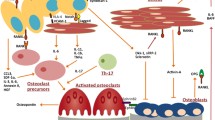Abstract
Myeloma behaves differently to other osteolytic tumours which metastasize to bone, in that the latter usually provoke reactive bone formation in the host bone. A previous study showed that a myeloma cell line (GM1500) secreted an osteoblast-inhibiting factor(s). The present study was undertaken to determine whether other myeloma cells also secreted a factor(s) which inhibited both cell proliferation and DNA synthesis of osteoblast-like cells and whether the myeloma also affected the function of osteoblasts. The results showed that a second cell line (Karpas 707) as well as myeloma tissue taken from two patients had a similar effect. The myeloma cells did not affect total collagen or protein synthesis, and did not affect the overall degree of mineralization. A biphasic effect was seen on alkaline phosphatase activity. Thus, although the proliferation of the pre-osteoblast was affected, the synthetic functions of the osteoblasts were not.
Similar content being viewed by others
References
Galasko CSB, 1986, Skeletal Metastases (London: Butterworths).
Galasko CSB, 1975, The pathological basis for skeletal scintigraphy. Journal of Bone and Joint Surgery, 57B, 353–359.
Milch RA and Changus GW, 1956, Response of bone to tumour invasion. Cancer, 9, 340–351.
Galasko CSB, 1982, Mechanism of lytic and blastic metastatic disease of bone. Clinical Orthopaedics Related Research, 169, 269–285.
Evans CE, Galasko CSB and Ward C, 1989, Does myeloma secrete an osteoblast inhibiting factor? Journal of Bone and Joint Surgery, 71B, 288.
Gallagher JA, Beresford JN, Sharrad M, Gowen M, Poser J, MacDonald E, McGuire MJB and Russell RGG, 1983, Human bone cell in culture—a novel system for the investigation of osteoblast function. Calcified Tissue International, 35 (Suppl), A24.
Ashton BA, Abdullah F, Cave J, Williamson M, Sykes BC, Couch M and Poser J, 1985, Characterization of cells with high alkaline phosphatase activity derived from human bone marrow: preliminary assessment of their osteogenicity. Bone, 6, 313.
Auf'mkolk B and Schwartz ER, 1985, Biochemical characterizations of human osteoblasts in culture. Normal and Abnormal Bone Growth: basic and clinical research (New York: A. R. Liss), pp. 201–204.
Evans CE, Galasko CSB and Ward C, 1990, Effect of donor age on the growth in vitro of cells obtained from human trabecular bone. Journal of Orthopaedic Research, 8, 234.
Evans CE, Galasko CSB and Ward C, 1986, In vitro proliferation of cells cultured from human cancerous bone. Cell Medicated Calcification and Matrix Vesicles, edited by Ali SY (Amsterdam: Elsevier), pp. 303–306.
Karpas A, Fischer P and Swirsky D, 1982, Human myeloma cell line carrying a Philadelpia chromosome. Science, 216, 997–999.
Durie BGM, Salmon SE and Murphy GR, 1981, Relation of osteoclast activating factor to extent of bone disease in multiple myeloma. British Journal of Haematology, 47, 21–30.
Lowry OH, 1955, A sensitive method for assay of phosphatases using dinitrophenol. Methods in Enzymology, 4, 371–372.
Ackerman GA, 1962, Substituted naphthol AS phosphate derivatives for the localization of leucocyte alkaline phosphatase activity. Laboratory Investigation, 11, 563.
Peterkovsky B and Diegelman R, 1971, Use of a proteinase-free collagenase for the specific assay of radioactive collagen in the presence of other proteins. Biochemistry, 10, 988.
Lowry OH, Rosebrough NJ, Farr AL and Randall RJ, 1951, Protein measurement with the Folin phenol reagent. Journal of Biological Chemistry, 193, 265.
Simmons DSJ, Kent GN, Jilka RL, Scott DM, Fallon M and Cohn DV, 1982, Formation of bone by isolated, cultured osteoblasts in millipore filter chambers. Calcified Tissue International, 34, 291.
Bellows CG, Aubin JE, Heersche JNM and Antosz ME, 1986. Mineralized bone nodules formed in vitro, from enzymatically released rat calvaria cell populations. Calcified Tissue International, 38, 143.
Stein GS and Lian JB, 1989, Molecular mechanisms associated with the relationship of cell growth and differentiation in osteoblasts. Proceedings of the American Society for Bone and Mineral Research, Montreal, pp. 16–24.
Owen M, 1980, The origin of bone cells in the post-natal organism. Arthritis and Rheumatism, 23, 1073.
Gerstenfeld LC, Chipman SD, Glowacki J and Lian JB, 1987, Expression of differential function by mineralizing cultures of chicken osteoblasts. Development Biology, 122, 49.
Shalhoub V, Gerstenfeld LC, Collart D, Lian JB and Stein GS, 1989, Downregulation of cell growth and cell cycle regulated genes during chick osteoblast differentiation with the reciprocal expression of histone variants. Biochemistry, 28, 5318.
Klein B, Jourdan M, Durie BGM, Rossi JF and Bataille R, 1987, Spontaneous production of bone cytokines by human myeloma cell lines. Journal of Bone and Mineral Research, 2, 41.
Mercola M and Stiles CD, 1988, Growth factor superfamilies and mammalian embryogenesis. Development, 102, 451.
Author information
Authors and Affiliations
Rights and permissions
About this article
Cite this article
Evans, C.E., Ward, C., Rathour, L. et al. Myeloma affects both the growth and function of human osteoblast-like cells. Clin Exp Metast 10, 33–38 (1992). https://doi.org/10.1007/BF00163574
Received:
Accepted:
Issue Date:
DOI: https://doi.org/10.1007/BF00163574




